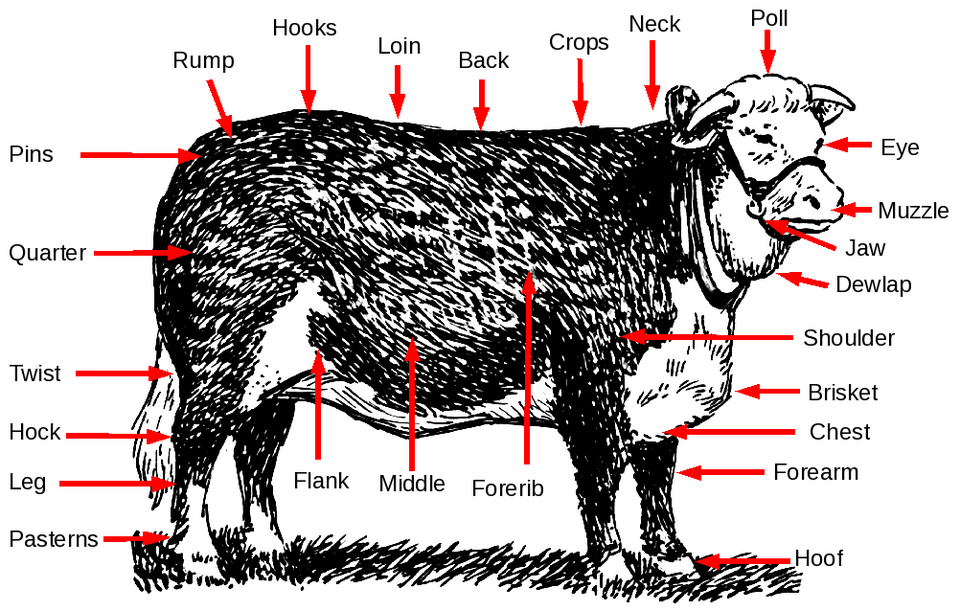Difference between revisions of "AY Honors/Cattle Husbandry/Answer Key"
m (1 revision) |
|||
| Line 1: | Line 1: | ||
| − | {{honor_header|2|1944|Outdoor Industries|General Conference}} | + | {{honor_header|2|1944|Outdoor Industries|General Conference|Cattle_Husbandry_Honor.png}} |
==1. Name at least 25 parts of a steer.== | ==1. Name at least 25 parts of a steer.== | ||
[[Image:Parts of a steer.png|thumb|600px|center]] | [[Image:Parts of a steer.png|thumb|600px|center]] | ||
Revision as of 02:23, 8 August 2012
1. Name at least 25 parts of a steer.
2. What are four characteristics of a good heifer?
3. What is castration, and what is its purpose?
Castration is the act of removing the testicles of a bull. It is also called steering, as the animal is thenceforth called a steer.
Castration is commonly performed on domestic animals not intended for breeding for the following reasons:
- To reduce or prevent territorial behaviour
- To reduce or prevent aggression
- To reduce other consequences of sexual behaviour that may make animal husbandry more difficult, such as boundary/fence/enclosure destruction when attempting to get to nearby cows.
- To increase growth and weight of the animal.
- To improve the taste of the meat.
4. Why is dehorning done, and what age is best for dehorning?
Cattle with horns can injur themselves, other cattle, and their handlers. They can also bruise the meat which lowers the value of the cattle. It is best done before the age of three months, as they are more easily handled when they are this young, and they also recover from the procedure more quickly. Dehorning cattle over the age of one year is illegal in many localities, as it is considered inhumane. The procedure should be performed in the late afternoon or early morning when flies are less abundant, and thus, infection less likely. It should never be performed in wet weather as it will take much longer for the wounds to heal.
5. What is creep feeding?
Beef cattle are bred to quickly build up their body mass while deemphasizing milk production. A beef cow's milk production will begin to taper off before its calf's need for it decreases, so creep feeding is introduced to fill the gap. A creep feeder is an enclosure that holds feed so that it can be easily accessed by a small calf, but not accessed at all by grown cattle.
Calves born in the early spring or late fall benefit the most from creep feeding because the availability of grass in the pasture is decreased during these times.
6. When is a calf weaned?
The ideal time to wean a calf is when it is six to eight months old, though there are a variety of factors that can affect this. In hard times, such as a drought, a calf could be weaned earier for the mother to get stronger before calving again. This will allow her secretory tissue to be restored before she calves again. Calves can be weaned as early as one month, when they begin eating grain and hay, optimal time for weaning is six months. The longer a calf is on a cow the healthier it will be and the faster it will grow.
7. What are the housing needs of cattle?
Cold weather will not hurt a cow so much as rain will. Cattle need a shelter they may enter whenever weather becomes too much for them. Such a shelter (like a barn or a simple shed) would provide enough cover. If they are able to be on pasture anytime they want then when they needed the protection of a barn they would go into it.
8. Why is it best to put feed and water at opposite ends of the pen from each other?
9. Identify live or from pictures three breeds of beef cattle and three breeds of dairy cattle.
Beef Cattle
[edit] Adventist Youth Honors Answer Book/Beef cattle breeds
Dairy Cattle
Adventist Youth Honors Answer Book/Dairy cattle breeds

